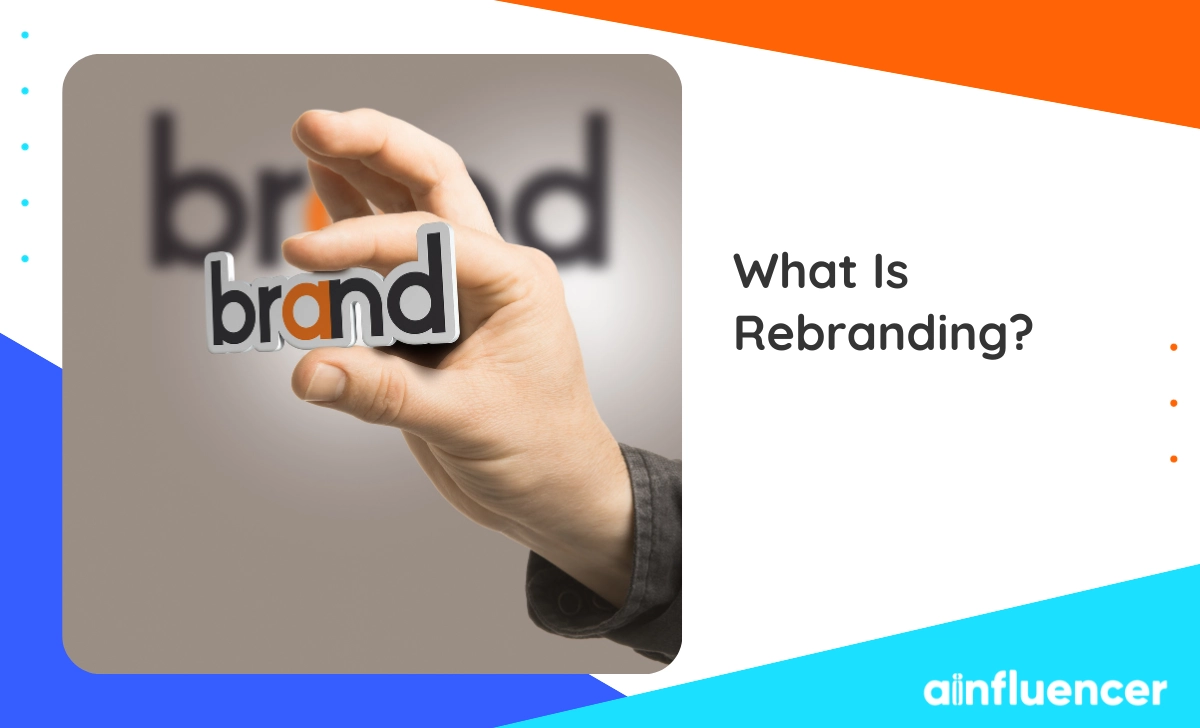Today, in the fast-moving world of business and marketing, rebranding is a powerful way for companies looking to adapt and stay relevant. It’s more than just changing logos and slogans; it’s a way to give a brand new life, make it more appealing, and simplify what it stands for.
In this guide, we’ll focus on making brands more well-known. We’ll cover the basics, strategies, and factors that help with this change. We’ll also explain how rebranding can change and how people can see your brand., As a result, you can boost growth, and most importantly, increase your brand awareness.
Let’s start with the rebranding definition.
What Is Rebranding?
Rebranding is a marketing strategy that involves giving an established brand a fresh identity to stand out and connect with consumers, investors, competitors, and others. This can mean making significant changes to the brand’s logo, name, legal identity, image, marketing approach, and advertising themes.
The purpose of these changes is usually to reposition the brand, sometimes to distance it from any negative associations linked to its old branding, or to make it more appealing to a higher-end market. Rebranding your business can also be a way to convey a new message or direction set by the brand’s leadership.
It also is a universal strategy used in various situations. It can make new, old, or upcoming products look fresh. This can happen when marketing strategies change or it may apply in specific situations such as a company undergoing financial restructuring, disbanding unions, or when a company aims to overhaul its entire image. This is particularly relevant if the company owns multiple brands and products.
What Are The Key Aspects of Rebranding?
Rebranding often includes making significant changes to various aspects that define a brand. As we said, these changes can contain the brand’s name, logo, visual appearance, the messages it conveys, and the overall strategy it adopts. To understand rebranding better, let’s read about its essential elements:
1. Motivation
Company rebranding could be for various reasons, including the need to modernize its image, recover from a bad reputation or crisis, adapt to market changes, appeal to a different audience, or signal a change in ownership or strategy.
2. Logo and Visual Identity
A highly visible part of the rebranding process is when a company creates a new logo and changes its overall visual style. This often means adjusting the colors, fonts, and design elements with the dynamic touch of a logo animation template to ensure they fit well with the brand’s new identity and the message it wants to communicate.
3. Name Change
In some cases, when a company is undergoing rebranding, it decides to change its name. This decision can be driven by factors such as unions or investments, where two companies come together and require a fresh name. It might also happen due to legal obligations that require a name change or simply because the company wants to create separation from its past associations.
4. Messaging
In rebranding, messaging refers to the words and phrases a company uses to tell people about its updated values, mission, and where it stands in the market. This can involve coming up with new slogans and strategies for how the brand communicates. It’s important that this messaging resonates with the target audience and accurately represents the brand’s aims and objectives.
5. Market Research
Market research is a vital part of a successful rebranding process. It means digging deep to understand your target audience (the people or groups your brand aims to reach), studying your competitors (other businesses in your field), and keeping up with the latest industry trends.
This research helps ensure your rebranding efforts are well-informed and positioned for success.
Through this research, a company can:
- Understand the audience: Learning about the preferences, needs, and behaviors of the target audience, including customer engagement, helps rebrand efforts to match their values and preferences.
- Analyze competitors: Studying what other companies in the same market are doing can help identify gaps in the market that the rebranded product or service can fill, or provide inspiration for how to stand out.
- Stay relevant: Keeping up with industry trends and changes is essential, as industries are constantly evolving, and staying current ensures that the rebrand remains competitive.
- Reducing Risks: Knowing the market well helps lower the chance of the rebrand not connecting with the audience or falling behind competitors.
6. Measuring success
Measuring rebranding success means closely tracking how well the changes are doing. These measurements help you know if your rebrand is working and if you’re reaching your goals, guiding you in making the right adjustments for success.
- How customers now see your brand.
- How your brand compares to competitors.
- If sales and revenue are going up.
- Key numbers like website traffic or customer loyalty.
Read also: What Is A Brand App And Why A Business Needs It?
How Long Does It Take to Rebrand A Company?
The time it takes to rebrand a company can vary widely and relies on factors like the rebrand’s complexity, the company’s size, and the nature of the changes. To give you a rough idea:
- Simple Rebranding: If the rebranding of a company involves updating visual elements like the logo without major shifts in messaging or positioning, it can be completed in a few months.
- Moderate Rebranding: When a company is simplifying its brand identity, including logo, design, messaging, and strategy, it may take around 6 to 12 months.
- Complex Rebranding: Extensive rebranding, such as a complete image overhaul, values, and positioning, can take 12 months or more. This may involve culture and process changes.
- Global or Large Corporations Rebranding: Large organizations, especially global ones, may take several years due to the scale and complexity of changes.
- Planning and Research: This phase adds time; market research, strategy development, and stakeholder buy-in can take several months before the rebranding work starts.
- Transition Period: After the rebranding is launched, there’s often a transition period where old and new brand elements coexist. This period can vary, lasting from a few weeks to several months.
How Much Does It Cost to Rebrand A Company?
The cost of rebranding a company can be different, based on things like how big the changes are, the size of the company, and what’s needed. For example, updating logos might cost a few thousand to tens of thousands of dollars, but a complete brand makeover for a big global company could cost millions. The cost also depends on whether they hire outside help, do market research, train employees, or run ad campaigns.
Read also: What Is A Brand App And Why A Business Needs It?
Conclusion
Rebranding is a powerful process that can transform a company or product by reshaping how people see it. To succeed requires careful planning and a deep understanding of the brand. Whether it’s a fresh start for a struggling business or a way to stay competitive, rebranding offers the chance for growth and recognition.
However, it should be approached carefully to avoid confusion or harm to the brand. With the right strategy, rebranding can breathe new life into a brand and open doors to exciting opportunities in the ever-changing world of business and consumer preferences.
FAQs
In short, rebranding means overhauling a company’s image and message to make it stand out from competitors and breathe new life into the business.
Rebranding is a powerful tool for businesses because it lets them craft their identity to match their goals and audience. It helps them convey their values, mission, and vision using elements like logos, colors, fonts, and messages.








![Read more about the article Top 10 Black-Owned Clothing Brands [for Men & Women in 2024]](https://blog.ainfluencer.com/wp-content/uploads/2023/11/Copy-of-Ainfluencer_Content_Images-7-1-1-1-2-1-1-300x182.jpg)
